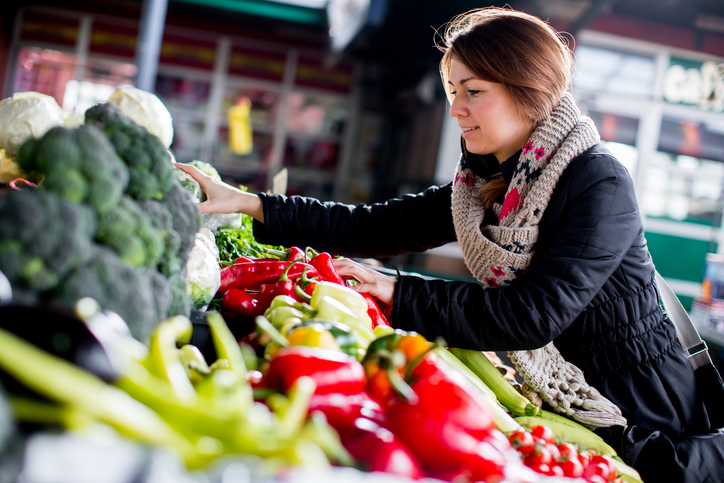The end of the summer is one of the best times for fresh produce. There are farmer’s markets where you get some of the best deals from farms nearby, but what happens when you spend a pretty penny on fresh vegetables and fruits, but when you get home, they’re not what you expected. Find out how to pick some of your favorite veggies and fruits so you won’t be disappointed when you eat them.
Watermelon
Many people pick up a watermelon by how pretty it looks, it’s perfect shape, but when picking up a watermelon it should feel heavy. They develop a splotch where they rest on the ground and when this area is creamy yellow, it’s ripe. You can also tap it and it should make a hollow sound hollow when it’s ripe.
Blueberries
Ripe blueberries are plump and deep blue with a dusting of gray on the surface. A blueberry that is firm or shows any hint of red isn’t fully ripened and will likely be tart. White and green colored blueberries are not ripe; leave them on the bush or in the store as they will not ripen. Blueberries that are purple, red or bluish may ripen after they are picked.
Mangoes
Look for mangoes that are football shaped rather than thin or flat. The flatter mangoes may be stringy. Avoid stringy looking, shriveled mangoes. The mangoes that are fuller and rounder usually have the deep color of a ripe peach instead of the yellowish green that the other varieties have. Avoid mangos with a sour or alcoholic smell. Because of their high sugar content, mangoes will ferment naturally.
Papaya
When buying papaya fruit look for mostly yellow with a bit of green fruit, which will fully ripen at home. The fully ripe papaya fruit is bright yellow. Papaya fruit should feel firm and heavy for its size. Avoid fruit that is overly soft, has blemishes or soft spots. If you smell at the base where the fruit was attached to the tree, it will have a nice light sweet smell.
Figs
As far as selecting good figs, you want them to be soft — to give a little with the slightest pressure, but not at all mushy or hard. Avoid figs with bruises and check to see that the stems are firmly in place — a wiggly, loose stem is a dead giveaway for a mushy fig.
Spinach
There are two types of spinach, baby spinach, and big leaf spinach. Both are packed with nutrients, but if you want sweet tasting spinach that is great for salads, then go for the baby spinach. Large leaf spinach will be more grainy, dirty, and sometimes bitter, which is better cooked. Picking spinach is easy because the leaves should have a deep green color and they welt fast, so if you see brown then it’s going bad.
Avocados
Place the avocado in the palm of your hand. Gently squeeze without applying your fingertips as this can cause bruising. If the avocado yields to firm gentle pressure you know it’s ripe and ready-to-eat. If the avocado does not yield to gentle pressure it is considered still “firm” and will be ripe for a couple of days. If the avocado feels mushy or very soft to the touch it may be very ripe to over ripe or black inside.
Cucumbers
No matter what kind you buy, look for cucumbers that are very firm and rounded right to the ends. Avoid any that have withered, shriveled tips. Although the overall size varies with the type, slender cucumbers typically have fewer seeds than thick or puffy ones. Beware of cucumbers that bulge in the middle, since they are likely to be filled with large seeds and have watery, tasteless flesh. Waxed or not, cucumber skin should be a rich green—not extremely pale and definitely not yellow (except, of course, for lemon cucumbers).
Eggplant
There are a lot of myths about eggplant and bitterness. Bitterness doesn’t come from too many seeds or from a certain shape or type; it comes from being over-matured. Small eggplants tend to be less bitter than larger ones. So be sure to choose eggplant that is firm, even hard to the touch. There should be no shriveling or soft spots. Also, check the calyx (the green leaves at the stem end); it should be fresh and green, not dried out and brown.
Mushrooms
Although there are different types of mushrooms available year-round, summer is the season for chanterelles and porcini varieties. When shopping for mushrooms, they should be dry and firm and, if open, should have gills that are intact and appear fresh. Avoid mushrooms that have dents because those are usually old mushrooms that are starting to spoil.
Beets
Select beets that are heavy for their size, that are firm with smooth blemish-free dark red or golden yellow skins. Make sure you choose those that still have their tops on since the greens are an indicator of freshness. If you want to cook any attached leaves, make sure they are bright green.
NEXT: Make a Tomato Cucumber Avocado Salad With Ingredients From Your Garden
